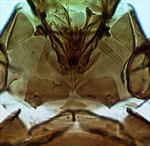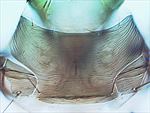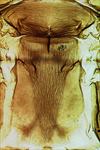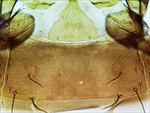
Male

Head & pronotum

Antenna

Prosternites

Pronotum (female, Virginia)

Mesonotum & metanotum

Pelta & tergite II

Female segments IX–X (tube)

Male segments IX–X (tube)

Fore wing
Both sexes fully winged. Body brown with reddish purple internal pigment; legs including all tarsi brown; antennal segment III yellow, IV largely yellow, V yellow at base (III–V sometimes more extensively brown); major setae brown; fore wings pale, scarcely shaded at base. Antennae 8-segmented; segment III with one sense cone, IV with 4 sense cones, VIII broad at base. Head distinctly longer than wide, widest across eyes; maxillary stylets scarcely retracted to postocular setae, at least one third of head width apart medially; eyes distinctly prolonged ventrally; postocular setae bluntly pointed, shorter than eye length. Pronotum with 4 pairs of weakly capitate major setae, midlaterals not developed, anteromarginals and anteroangulars variably reduced and sometimes pointed; prosternal basantra and ferna well developed, mesopresternum reduced to paired lateral triangles. Fore tarsus without a tooth. Metanotum closely striate medially. Forewing constricted medially, with about 10 duplicated cilia; sub-basal seta S3 pointed and slightly longer than capitate S1 and S2. Tergite IX setae S1 finely acute, longer than tube.
Male similar to female, fore tarsus without a tooth; tergite IX setae S2 short and stout; sternite VIII with no pore plate; pseudovirga of aedeagus slender.
The genus Leptothrips is related to Haplothrips, but the metanotal sculpture is closely striate not reticulate, and larvae and adults usually have extensive purple internal pigment. Currently, 30 species are listed under Leptothrips, all from the Americas. Johansen (1987) described 22 new species in the genus, with 11 Leptothrips recorded from California. However, Mound & O'Donnell (2017) placed nine species into synonymy and recognised only 15 Leptothrips species from North America of which nine are reported from California. The holotype of maliaffinis described by Johansen (1987: 61) was a female from a population in Virginia that was studied by Parrella et al. (1982) when investigating the biology of the Black Hunter, L. mali. The mali-group comprises heliomanes, larreae, mali, mcconelli and papago, but biological evidence for the existence of each of these as separate entities remains weak. Three further nominal species that are similar to mali in general appearance are cassiae, macroocellatus and oribates, but each of these has the pronotum with little or no sculpture medially.
Larvae and adults predatory on other small arthropods (Parrella et al., 1982), and associated with many different trees (Parrella et al., 1982). L. gurdus was based on five specimens collected from Juglans and Ficus carica.
Widespread across North America, from the Northeast to California, and also Mexico, Paraguay, and Argentina.
PHLAEOTHRIPIDAE, PHLAEOTHRIPINAE
Leptothrips mali (Fitch)
Phloeothrips mali Fitch, 1854: 806
Cryptothrips aspersus Hinds, 1902: 205
Cryptothrips californicus Daniel, 1904: 293
Cryptothrips adirondacks Watson, 1921: 83
Leptothrips gurdus Johansen, 1987: 45
Leptothrips septemtrionalis Johansen, 1987: 55
Leptothrips maliaffinis Johansen, 1987: 61.
Johansen RM (1987) El genero Leptothrips Hood, 1909 (Thysanoptera: Phlaeothripidae) en el continente Americano: su sistematica, filogenia, biogeografia, biologia, conducta y ecologia. Monografias del Instituto de Biologia. Universidad Nacional de Mexico 3: 1–246.
Mound LA & O’Donnell CA (2017) Predation, phytophagy and character state confusion among North American species of the genus Leptothrips (Thysanoptera: Phlaeothripinae). Zootaxa 4294 (3): 301–315.
Parrella MP, Rowe DJ & Horsburgh RL (1982) Biology of Leptothrips mali: a common predator in Virginia apple orchards. Annals of the Entomological Society of America 75: 130–135.